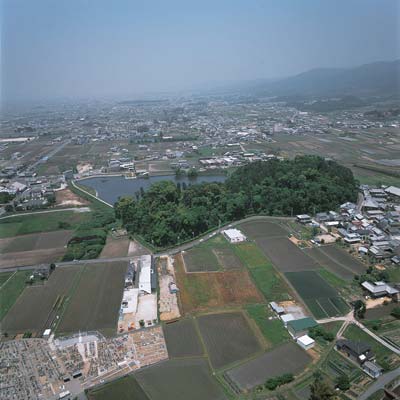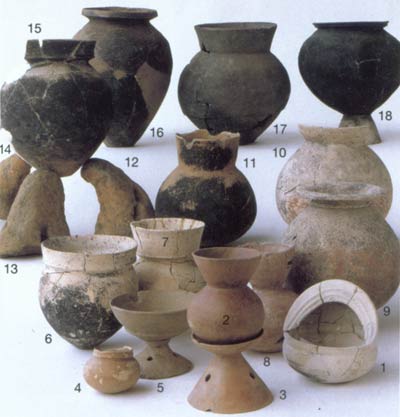Makimuku:
Were the huge buildings, neatly lined up, a palace?
A discovery enlivens debate over the country of Yamatai.
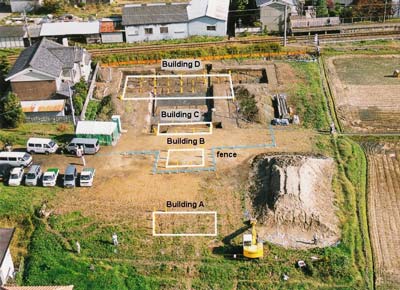
A group of neatly aligned buildings Four buildings and a fence built in the first half of the third century have been found. They are seen to have been built with a common axis and orientation. Adapted from Hakkutsu sareta Nihon rettō 2010 [Excavations in the Japanese Archipelago, 2010] (Bunkachō [Agency for Cultural Affairs], ed., Asahi Shimbun Publications, 2010). |

Large-scale Building D Boasting the largest scale among the four structures found, its dimensions are reconstructed as 19.2 m north-south by 12.4 m east-west, in the highest class for its time. |
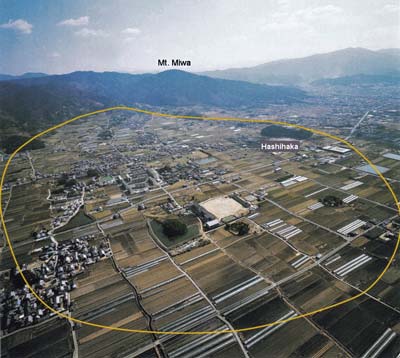
Panorama of the Makimuku site (from the west) The Makimuku site spreads northwest from Mt. Miwa, worshipped from ancient times as an object of religious belief. Adapted from Hakkutsu sareta Nihon rett 2010 [Excavations in the Japanese Archipelago, 2010] (Bunkachō [Agency for Cultural Affairs], ed., Asahi Shimbun Publications, 2010). |
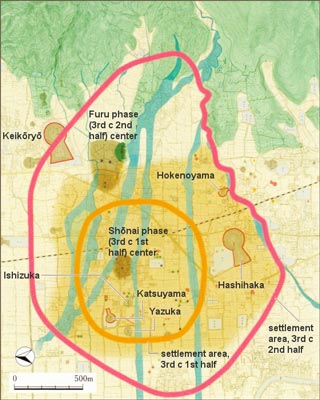
Setting of the Makimuku site Features extend atop slightly elevated locations set between rivers. At the time of the site's appearance in the first half of the third century (Shōnai pottery phase) its area was approximately 1 km in diameter, and at its height in the latter half of the third century (Furu pottery phase) it grew in extent to approximately 2 km east-west by 1.5 km north-south. Adapted from Hakkutsu sareta Nihon rett 2010 [Excavations in the Japanese Archipelago, 2010] (Bunkachō [Agency for Cultural Affairs], ed., Asahi Shimbun Publications, 2010). |
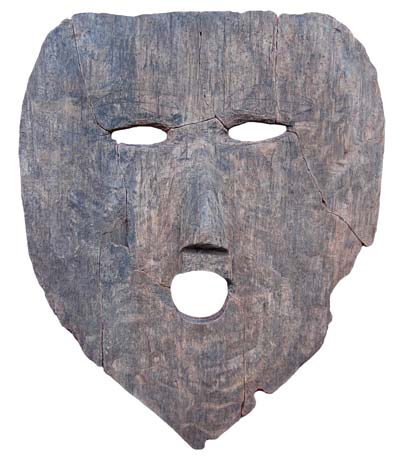
Wooden mask
|

Wooden shield fragment
|

Wooden scythe handle
|
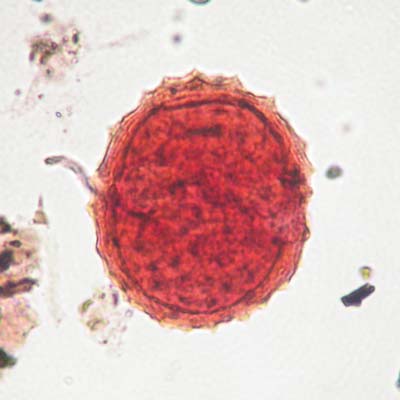
Safflower pollen
|
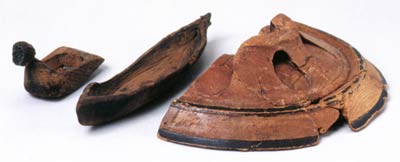
Wooden implements Early Kofun period, third century. (Item at left, waterfowl-shaped wooden implement) Length: 19.4 cm; greatest width: 9.5 cm; cypress. (Item at center, boat-shaped wooden implement) Length: 41.0 cm; width: 9.6 cm; cypress. (Item at right, foot portion of a wooden pedestaled dish) Diameter at base: 45.5 cm; zelkova. Together with pottery, a boat-shaped wooden implement, and many wooden artifacts including a pedestaled dish, plus natural wood and charred wood were recovered from a pit. Many of the wooden implements were partially burned. These items are thought to have been used in ritual conducted in the Early Kofun period. (Kitai Toshiyuki) | |
Adapted from Hakkutsu sareta Nihon rett 2010 [Excavations in the Japanese Archipelago, 2010] (Bunkachō [Agency for Cultural Affairs], ed., Asahi Shimbun Publications, 2010).
Makimuku Site, Sakurai City, Nara Prefecture
The vast birthplace of the early Yamato polity
Makimuku is a settlement site from the start of the Kofun period, spreading across the vicinity of the JR Makimuku station in the southeast portion of the Nara basin. Stretching approximately 1.5 km north-south by 2 km east-west, it is famous throughout the nation as the birthplace of the early Yamato polity, and as the eastern candidate competing with various sites of Kyushu as the locus of the country of Yamatai, noted in the History of the Kingdom of Wei.
Although at present excavations have been conducted continuously more than 167 times since 1971, the area of investigation is less than five percent of the total estimated for the site, and many aspects of its nature remain unclear.
The first city in Japan ?
The site's duration is roughly from the start of the third century to the beginning of the fourth, and points of difference from ordinary settlements noted for it include the extremely large area, the pottery brought in from other regions accounting for 15 - 30 percent of the total, the broad area of that pottery extending from northern Kyushu to southern Kantō, and the early mounded tombs (kofun) such as Hashihaka, Makimuku Ishizuka, and Hokenoyama built there in concentrated fashion. Because of this, views have been expressed that it was the first city in Japan, or site of the first palace of the early Yamato polity.
Another characteristic is the discovery of a variety of unusual artifacts, and investigations of recent years have also found items such as safflower pollen from the mid-third century, the oldest such discovery in Japan, and a wooden mask from the start of that century.
A group of buildings, of the largest class, neatly aligned
During excavations conducted in recent years within the settlement area, a group of buildings has been detected from the first half of the third century sharing the same axis and orientation, and included among these are large buildings boasting the greatest scale for the time, a discovery drawing close attention for considering the history of the formation of the ancient Japanese state. (Hashimoto Teruhiko)

